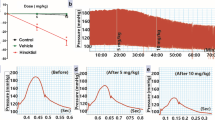Summary
Antihypertensive drugs have differing effects on renal hemodynamics, tubular function, plasma electrolytes, and hormonal responses. Nonselective β-blockers without intrinsic sympathomimetic activites, such as propranolol, have been reported to reduce renal blood flow and to cause a modest decrease in glomerular filtration rate. Carvedilol is a new multiple action agent displaying nonselective β-blockade without intrinsic sympathicomimetic activity, α1-adrenoceptor blockade (probably responsible for its vasodilator activity), and possibly also calcium antagonist properties. The presence of these different pharmacodynamic properties results in a different effect on the kidney as compared with, e.g., propranolol. In the dog, intrarenal infusion of carvedilol resulted in a renal vasodilator response with preservation of renal blood flow and without inducing sodium retention; in contrast, propranolol induced a renal vasoconstrictor response and sodium retention in this model. A renal vasodilator response to carvedilol was also reported in spontaneously hypertensive rats (SHR) and in DOCA-salt SHR. In contrast to labetalol, i.v. infusion of hypotensive doses of carvedilol in conscious SHR did not cause sodium retention. Carvedilol was effective in controlling hypertension and preserving renal function in a rat model of progressive hypertensive renal disease. In patients with essential hypertension, carvedilol was reported to reduce renal vascular resistance in the presence of reduced perfusion pressure, allowing for normal renal autoregulation of renal blood flow. Although a small reduction in glomerular filtration rate was seen after acute administration, renal function was preserved during chronic treatment. It is concluded from these studies that renal perfusion and renal function are well maintained during acute and chronic treatment with carvedilol. The compound does not appear to cause sodium retention, and preliminary animal test data suggest the possibility of a renoprotective effect.
Similar content being viewed by others
Abbreviations
- SHR:
-
spontaneously hypertensive rats
References
Bauer JH, Brooks CS (1979) The long-term effect of propranolol therapy on renal function. Am J Med 66:405–410
Dupont AG, Van der Niepen P, Taeymans Y, Ingels M, Piepsz A, Bossuyt AM, Block P, Six RO, Jonckheer MH, Vanhaelst L (1987) Effect of carvedilol on ambulatory blood pressure, renal hemodynamics, and cardiac function in essential hypertension. J Cardiovasc Pharmacol [Suppl 11] 10:S130-S136
Epstein M, Oster JR (1982) Beta-blockers and the kidney. Miner Electrolytes Metab 8:237–254
Epstein M, Oster JR (1985) Beta-blockers and renal function. A reappraisal. J Clin Hypertens 1:65–99
Kohno M, Murakawa K, Okamura M, Yasunari K, Yokokawa K, Horio T, Inoue T, Takeda T (1988) Effects of long term administration of carvedilol on renal haemodynamics and functions in DOCA salt-induced accelerated hypertension of spontaneously hypertensive rats. Durgs [Suppl 6] 36:165–168
Leeuw de PW, Birkenhäger WA (1982) Renal response to propranolol treatment in hypertensive humans. Hypertension 4:125–131
London GM, Safar ME, Sassard JE, Levenson JA, Simon AC (1984) Renal and systemic hemodynamics in sustained essential hypertension. Hypertension 6:743–754
London GM, Safar ME, Marchais S (1986) Renal blood flow in man with essential hypertension. Am J Nephrol [Suppl 2] 6:8–11
Nakamoto H, Suzuki H, Katsumata H, Ohishi A, Sarnia T, Sakaguchi G (1988) Effects of carvedilol on renal function and blood pressure in three-fifths nephrectomised spontaneously hypertensive rats loaded with high salt. Drugs [Suppl 6] 36:160–164
Piepsz A, Ham HR, Dupont AG (1989) Renal blood flow in renal disease and hypertension. In: Blaufox MD (ed) Evaluation of renal function and disease with radionuclides the upper urinary tract. Karger, Basel, pp 150–194
Preston RA, O'Connor DT, Stone RA (1979) Prazosin and renal hemodynamics: arteriolar vasodilatation during therapy of essential hypertension in man. J Cardiovasc Pharmacol 1:277–286
Ruffolo PR Jr, Gellac M, Hieble JP, Willette RN, Nichols AJ (1990) The pharmacology of carvedilol. Eur J Clin Pharmacol 38: S82-S88
Ruffolo RR Jr, Sauermilch CF, Willette RN (1990) Hemodynamic differences between carvedilol and labetalol in the cutaneous circulation. Eur J Clin Pharmacol [Suppl 2] 38:S112-S114
Schlueter WA, Battle DC (1989) Renal effects of anti-hypertensive drugs. Drugs 37:900–925
Tamaki T, Hasui K, Yamamoto A, Aki Y, Shoji T, Nakamura A, Kimura S, Fukui K, Iwao H, Abe Y (1988) Renal vasodilatory action of carvedilol in the dog. Drugs [Suppl 6] 36:155–159
Zanchetti A, Leonetti G (1985) Natriuretic effect of calcium antagonists. J Cardiovasc Pharmacol [Suppl 4] 7:533–537
Author information
Authors and Affiliations
Rights and permissions
About this article
Cite this article
Dupont, A.G. Carvedilol and the kidney. Clin Investig 70 (Suppl 2), S127–S131 (1992). https://doi.org/10.1007/BF00207623
Issue Date:
DOI: https://doi.org/10.1007/BF00207623




